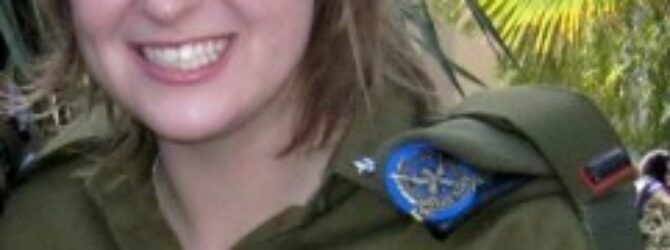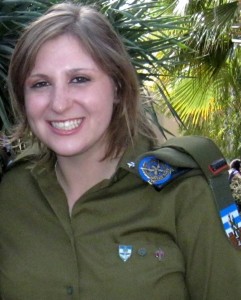
How Do Goods Get to Gaza? We Asked the Officer in Charge
2nd Lt. Nira Lee grew up in Tempe, Arizona, completed her undergraduate degree at American University in Washington, DC, and moved to Israel in May 2010. She joined the IDF in October 2010. Nira currently serves in COGAT as the assistant foreign liaison officer to international organizations in the Gaza Strip. She agreed to answer a few questions about her work.

2nd Lt. Nira Lee
First of all, what is COGAT?
COGAT stands for the Coordinator of Government Activities in the Territories. It’s the unit of the IDF that is responsible for implementing the Israeli government’s policy in Judea and Samaria as well as facilitating the movement of goods and people to and from Gaza Strip.
What is your specific role?
My primary job is to work with international organizations and delegations in the Gaza Strip to coordinate the entry/exit of the goods and supplies that they wish to transfer. In addition, I also coordinate the movement of international organizations inside the security buffer zone in Gaza — including ambulances and fire trucks in case of emergency — as well as visits to the Kerem Shalom crossing.
It’s a difficult but important job. Remember, Gaza is ruled by Hamas, a terrorist group that wants to destroy Israel and has fired thousands of rockets at Israeli civilians in recent years. The IDF, therefore, does not coordinate with Hamas, which is why it’s important that we maintain strong relationships with the international organizations that work with uninvolved civilians in Gaza.

2nd Lt. Nira Lee coordinates the entrance of Palestinian ambulances into the Gaza Strip.
What’s the difference between the Erez and Kerem Shalom crossings?
Erez is the pedestrian crossing between Gaza and Israel. Every day, about 300 people go through, including employees of international organizations, foreign diplomats, journalists and, of course, Palestinians.
Kerem Shalom is the commercial goods crossing. Every day, around 250-350 trucks go through. Our role is to authorize the materials — food, electrical products, clothing, construction materials – and coordinate the trucks.
There used to be other crossings, but they were closed due to repeated rocket attacks. In order to maintain the flow of goods into Gaza, we expanded Kerem Shalom, and now the crossing has a greater capacity than there is demand from Gaza.

During Operation Pillar of Defense, the IDF continued to facilitate the transfer of goods into Gaza via the Kerem Shalom crossing.
Who exactly receives the supplies in Gaza? And who pays for them?
The supplies I send in are shipped directly to the international organizations that I coordinate imports with, such as the Red Cross and UNRWA. They are the ones who place the orders, and they are the ones who pay for it. We don’t deal with payments — this is all done privately between organizations and their suppliers. These organizations either distribute the goods to merchants within the private sector or stock their warehouses with the supply. The Red Cross sends its supplies to the Ministry of Health or to individual hospitals and health centers.

Michael Harvey, the USAID mission director in the West Bank and Gaza (left) and 2nd Lt. Nira Lee (center) near Gaza
What was your role during Operation Pillar of Defense?
I was doing everything I could to assist civilians in Gaza — Palestinians and foreigners — by working closely with the international organizations in Gaza. Like most soldiers elsewhere in the IDF, I did not sleep much during those eight days. I spent a great deal of time coordinating the entrance of goods as well as the evacuation of Palestinian ambulances with medical patients from the buffer zone. I also helped arrange for over 60 foreigners to leave Gaza.
During the operation, rockets were fired at Kerem Shalom and Erez. How did that affect your work?
As you can imagine, working under rocket fire doesn’t make anybody’s job any easier. During Operation Pillar of Defense my unit’s goal was to open Kerem Shalom for several hours each day in order to transfer medical supplies and food shipments into Gaza.
We had to shut the crossing because of Hamas rocket fire. On Nov. 20, right in the middle of transferring goods, there was a rocket attack. Some trucks crossed before the rockets hit, but others were forced to wait. That night, we stayed up trying to figure different ways to to get the medical supplies into Gaza. Eventually we settled on a plan to use forklifts at Erez.

Nira Lee with soldiers in her department
Do you feel that you accomplished your goals?
I do. On the day that we sent the goods through Erez, I called all of the major organizations in Gaza that import medical supplies and drugs and asked them if there was anything they needed urgently. Every organization except one declined the offer. In fact, one of the items that was requested in Gaza during the operation was Bamba — a popular Israeli snack for children.
By the end of the operation, every international organization that had requested to bring in medical supplies or food was able to do so.
Now, only a few weeks after the operation, I have received only a small number of requests for emergency aid, and each of those requests were approved and imported within two days.
Have you built any kind of personal relationships with people working in Gaza?
Yes, definitely. I won’t soon forget that when I cut my hand while diving for cover from a mortar shell, the UN officers who were stationed on my base helped me clean and bandage the wound.
There is one person who stands out above all others. Every day, I coordinate shipments of goods with a young woman from Gaza who works for one of the major international organizations in the region. Last month, we were together for a meeting in Israel when a rocket siren went off. Not knowing quite what to do, she froze and just looked at me as everyone around us began to run. There was no time to explain, so I just grabbed her hand and we ran — a woman from Gaza and IDF officer — to a shelter together.
When we spoke that evening, her voice shook as she told me that the bond she felt with me that day challenged all she had been taught about IDF soldiers. Not one of the eight days of Operation Pillar of Defense passed without us checking in on each other, without any connection to our work. Every night I made her promise to call me if she needed anything.
I have good relationships with many employees of international organizations in Gaza. Even if our politics may differ, we work together professionally and respectfully. They know me, they know that I treat all of their requests with importance, and they know that I work day and night in order to enable them to do their work.
Related posts:
Infographic: In One Week, 34,062 Tons of Goods Entered Gaza
Infographic: Last week, 32,401 Tons of Goods Entered Gaza
Infographic: Last week, 32,800 Tons of Goods Entered Gaza
